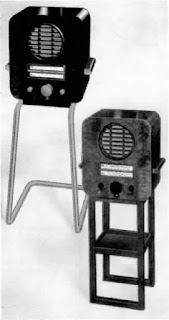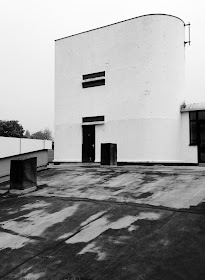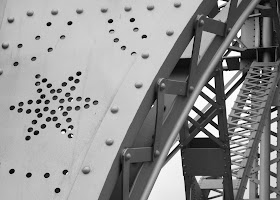Archaeology : Architecture : Art : Cold War : Curiosities : Design : Eccentricities : Ekco : Engineering : Industrial Heritage : Military : Petroliana : Photography : Shed Wonders : Transporter Bridges : Vintage Technology
20 December 2017
Wavox - Milk Monitor
Manufactured by Truvox, of Wembley, London, the Wavox is an Art Deco-esque extension speaker of the 1950s. Truvox manufactured public address systems, cinema speaker systems, industrial cleaning machines, and heaters. In 1949 it acquired Rola Celestion, but disappeared in 1969 through a reverse take-over. Celestion Industries Plc now uses Truvox as a brand name for loudspeakers.
Housing a Merco speaker, the case is made of a casein-based polymer. Casein is a phosphoprotein present in milk, more commonly used in making cheese. Casein polymer is these days used in any volume only for making buttons. Wavox extension speakers were available in a small range of rather unpleasant colour-ways, including blue/pink. This example is a much more sedate combination of gloss black and matte off-white.
07 December 2017
Ekco Radio Stands
Ekco is known to have produced stands for eight of its iconic Bakelite radios of the 1930s and 1940s. There is direct contemporary evidence, from an Ekco leaflet of 1935 (above), for stands for two of the company's five round radios - the AC/AD76 and the AD36, both inspired by Wells Coates' 1932 styling for the AD65 - and for the AC/AD86 'Dougal', styled by Serge Chermayeff. All three of these radios were released in 1935.



There's also photographic evidence of contemporary Ekco stands for the AC/AD85 of 1934, inspired by Wells Coates' design work (image not available for copyright reasons but available online); and for the AC/DC74 of 1933, styled by Chermayeff. Two stands were available for this last. One, in chromed tubular steel, price £1.15s.0d, for the black and chrome version of the set (above left, copyright Robert Chesters). Another, in wood, half the cost at £0.17s.6d, for the 'walnut' version (above centre).
A choice of wooden and chromed tubular steel stands, similar to those for the AC/DC74, were available for the AC/DC64, also styled by Chermayeff. A wooden stand could be had for the AD65 (above right). And, finally, an Ekco publication of 1936 for dealers lists a wooden stand for the AD37, although no image is known. No stands were available for the round A22 or AD75 radios. A complete collection of original Ekco stands would hold ten examples, excluding the wooden colour variants.
The wooden stands were of beech, and sported design cues that reflected those of the radio for which they provided support. They were available in both brown and black, likely coloured toner subsequently sealed with cellulose lacquer, to match the principal colours in which the radios were made. Stands without curves to the supporting platform are modern incarnations, not Ekco originals.

In about 1987 the radio and stand, still paired, passed locally to Graham Richardson, only the second owner. Now in the hands of its third owner, the radio (still entirely functional, without any restoration work having ever been done) and stand remain together. The stand is undoubtedly contemporary with the radio, and unique.
(My thanks to Robert Chesters for some of the information in this post.)
11 November 2017
X-Ray Specs

Likely manufactured in the late-1960s but updated in the mid-1980s - the Freed transformer inside is dated August 1969, but the Soderberg anti-collision beacon October 1985 - this Halsey industrial X-ray warning device was used by the United States military. The item bears an affixed metal plate, plus a sticker from the time of its disposal, that together provide valuable information on its origins.
The Disposal Turn-In Document (DTID) number acts as a unique disposal serial number. The first six places provide the Address Activity Code. FB5587 is RAF Lakenheath. The light was, thus, used by the USAAF. The next four places indicate the date the item was catalogued for disposal. Per the US military's adaptation of the Julian dating system, 9196 is 6 April 1991.
The National Stock Number (NSN) system was standardised by NATO in 1974 to track military assets, although versions of it existed prior. The first four places indicate the Federal Supply Classification Group. FSCG 9905 is for signs, advertising displays and identification plates: even military ID plates have their own ID codes! 00 in the fifth and sixth places indicates the United States.
Demilitarisation Codes indicate the degree of physical destruction required. DEMIL: A denotes a non-munitions/non-strategic item that does not demand any such. $2,245.63 is understood to be the asking price at disposal in 1991, over £3,000 at 2017 prices. The Federal Condition Code is given as A1 - serviceable without qualification, new/unused.
Halsey was a trademark of Post Glover Medical Products, of Erlanger, Kentucky. Established in 1938, the company supplied medical items, including X-ray illumination boxes. It still trades, as PG LifeLink. The light would have been supplied via the Warner Robins Air Logistics Center, Georgia, part of the USAAF's Materiel Command.
Shaped like a truncated pyramid, the device stands 29 inches tall. When switched on the Lucite panels are illuminated from within, and the twin bulbs in the beacon rotate within the red glass housing. Built to operate on US 115v mains, the light has been converted to run on UK 240v, with a new transformer inserted to provide steeped-down voltage for the 28v DC beacon. The original transformer and Hubbell connectors have been left in place, to enable any future reinstatement to the original set-up.
(Many thanks to Steve and Karen Myciunka, of Mullard Magic, for assistance with the item's history; and to various members of the UK Vintage Radio Repair and Restoration Forum for advice and parts.)
16 October 2017
Munrow Sports Centre, Birmingham
The Munrow Sports Centre was constructed in phases as part of the University of Birmingham's expansion plan of the 1950s. It is due for demolition. The athletics track was built in 1951, and now lies three-quarters covered by spoil from construction of the university's new library.
The multi-building design was created by Chamberlin, Powell and Bon (famous for the Barbican Estate in London), but never fully realised. Phase one, commenced in 1963 and completed in 1966, provided for two sports halls/gymnasia.
30 July 2017
Ekco Microphone
This six inch tall moving coil microphone was likely released by Ekco in about 1934, as the design echoes that of their first round radio, the AD65, released that year. There is little available information on these Ekco Bakelite-cased microphones, but it was quite possibly for use with a home recorder.
17 July 2017
Gumball, Rallied
Bought from a yard sale in Morgantown, Indiana, this XYZ Vending Bulk-PRO triple-head gumball machine is not as old as originally imagined. XYZ Vending was founded in Atlanta, Georgia, in 2003, and closed in 2009. But for $8 one can't go far wrong.
The cabinet was separated into three parts and the kinks hammered out. It was rubbed down with steel wool, sprayed with two coats of epoxy primer, and then with a number of coats of red lacquer. New cam locks were fitted to the lid, through which the machine is filled, and to the rear door, through which the quarters are collected.
The triple volume-control and delivery wheel mechanism was stripped down, scrubbed, disinfected, and put through the dishwasher. The metal springs and screws were cleaned-up with a brass wire brush as the mechanism was reassembled.
Each of the three coin mechanisms was cleaned and greased. The brightwork was brought back to life with the aid of fine steel wool. Scratches to the polycarbonate windows were reduced with judicious use of car polish, the 25¢ labels carefully preserved. A pipe stand was sourced, stripped and sprayed gloss black. Just gumballs to add.
21 May 2017
Duluth Aerial Ferry/Lift Bridge
Just 19 transporter - in the States known as aerial transfer or aerial ferry - bridges were built to completion worldwide, all between 1893 and 1916, except for one of 1938. Such structures were very much a European phenomenon; only one was ever constructed in North America, at Duluth, MI. (The Sky Ride built for the 1933 Century of Progress World's Fair in Chicago is often cited as a transporter bridge, but was in fact an aerial tramway.)
Duluth, at the western end of Lake Superior, is the largest inland port in the world. In 1870-71 the Duluth Ship Canal was cut through Minnesota (alternatively Park) Point, a seven mile long sand spit, in order to provide sheltered docks. Much of the spit was rendered an island. Ferries crossing the canal were unable to operate due to ice in winter, during which an inadequate suspension footbridge would be erected.
A 1891 competition sought a solution. The city decided to pursue one of the submitted proposals, for a vertical lift bridge designed by John Alexander Low Waddell, but the scheme foundered the following year due to objections from the War Department. Waddell's lift bridge was ultimately built, in 1894, but in Chicago, as the Halstead Street Bridge. A second competition sought a tunnel solution, but this idea sank too.
Meanwhile, between 1896 and 1902, the canal was widened and deepened. Thomas F. McGilvray, City Engineer at the time, inspired by the transporter bridges of Europe, in 1899 sketched one such, although of trussed rather than suspension form, as a way forward. The engineer C.A.P. Turner turned the sketch into a design, approved in 1901. The bridge had a main span of 393' 9", provided for a clearance of 135' above mean high water, and carried a gondola suspended by rigid steel hangers, instead of cables.
The foundations, built by Hugo & Timms, of Duluth, were completed by March 1902. However, funding difficulties with the American Bridge Company, and then steel supply problems affecting their subsidiary, the Duluth Canal Bridge Company, meant the bridge itself didn't proceed. DCBC's contract lapsed in May 1903.
Construction, by the Modern Steel Structural Company, of Waukesha, WI, finally commenced in July 1904. The first crossing of the gondola, 50 feet long, and 30 feet wide, took place on 23 February 1905. The crossing took about 1¼ minutes. Load-tested with 65 tons on 24 March, the bridge opened to the public three days later. The first car, an electric Studebaker Stanhope, crossed on 8 April.
However, as was the case with all transporter bridges, increased car ownership and usage rendered the bridge inadequate to demand by the mid-1920s. A redesign was undertaken in 1927 by John L. Harrington, of Harrington, Howard & Ash, of Kansas City. The solution was a lift bridge, remarkably similar to that designed by Waddell, with whom Harrington had once been a partner. The design was approved by the city in February 1927 and in January the following year received the blessing of Congress.
The contract was awarded to the Kansas City Bridge Company in February 1929, and work started the next month. The gondola crossed the canal for the last time on 1 July 1929. The re-engineering involved raising the towers 41 feet to accommodate the deck without compromising the 135' clearance, and strengthening them to carry the additional weight by building additional towers within the old ones. To avoid interruption to shipping, the 900 ton moving deck, counterbalanced by a 450 ton concrete weight in each tower, was constructed in the lifted position.
The converted bridge was first used on 12 January 1930. As ships and boats approach they blow a long-short-long-short signal on their horn, although lifts, which take just a minute, are largely radioed for about 1½ miles out. The signal is copied back by the bridge on its pair of Westinghouse Air Brake locomotive horn sets. There are about five thousand lifts per year. The bridge was added to the National Register of Historic Places in May 1973.
26 March 2017
Venner Time's Right
Venner is synonymous with time switches: Robert Francis Sidebottom Venner was the electrical engineer who invented them. His business was founded in 1906. It was incorporated in 1911 as Venner Time Switches Ltd, a private company; went public in 1937; and was acquired in 1970 by AMF (American Machine and Foundry Co.) International. Venner's electromechanical time switches provided clockwork back-up to electrically-driven mechanisms, most typically in street lighting. The company was also responsible for the initial installation at pedestrian crossings of very many of the UK's Belisha beacons.
04 March 2017
08 February 2017
Warsaw Uprising Memorial
The Warsaw Uprising was an attempt by the Polish resistance, commencing 1 August 1944 after nearly five years of German occupation, to liberate the Polish capital. It was timed to coincide with the approach to the city of the Soviet Army. The Uprising was supported by the Royal, South African, Polish and (for just one day) US Army air forces, and by the Polish First Army.
The resistance forces had control of much of the city centre by 4 August. Circa 1,200 Polish Army soldiers managed to cross the River Vistula, but the Soviet Army deliberately stopped short of the city and sat out events, as the USSR wanted to weaken Polish resistance to its intention to annex the country for itself. The Soviets had an air base just five minutes flying time from Warsaw, but their air force failed to back the Poles. They even refused to allow Allied air forces to land.
The Uprising was utterly crushed. About 8,000 of the German and about 16,000 of the Polish combatants were killed. Between 150,000 and 200,000 civilians were executed by the Germans. A further 700,000 civilians were expelled from the city. When the Poles surrendered on 2 October 1944 the Germans systematically levelled more than a third of Warsaw, which was 85% destroyed by the end of the war. The Soviets waited until the Germans had left before entering the city.
Communist control of Poland post-WWII meant that the Uprising went without a memorial for over four decades. On 1 August 1989, the 45th anniversary of the Uprising, the hundreds of thousands of people immolated by totalitarianism were finally granted an official memorial. Designed by the sculptor Wincenty Kućma and the architect Jacek Budyn, the memorial is in two parts: a resistance group running from a collapsing building, and another entering the sewers via a manhole cover. May all rest in peace.
The resistance forces had control of much of the city centre by 4 August. Circa 1,200 Polish Army soldiers managed to cross the River Vistula, but the Soviet Army deliberately stopped short of the city and sat out events, as the USSR wanted to weaken Polish resistance to its intention to annex the country for itself. The Soviets had an air base just five minutes flying time from Warsaw, but their air force failed to back the Poles. They even refused to allow Allied air forces to land.
The Uprising was utterly crushed. About 8,000 of the German and about 16,000 of the Polish combatants were killed. Between 150,000 and 200,000 civilians were executed by the Germans. A further 700,000 civilians were expelled from the city. When the Poles surrendered on 2 October 1944 the Germans systematically levelled more than a third of Warsaw, which was 85% destroyed by the end of the war. The Soviets waited until the Germans had left before entering the city.
Communist control of Poland post-WWII meant that the Uprising went without a memorial for over four decades. On 1 August 1989, the 45th anniversary of the Uprising, the hundreds of thousands of people immolated by totalitarianism were finally granted an official memorial. Designed by the sculptor Wincenty Kućma and the architect Jacek Budyn, the memorial is in two parts: a resistance group running from a collapsing building, and another entering the sewers via a manhole cover. May all rest in peace.
27 January 2017
Enniskillen - Eulerian Bridges
Located between the Upper and Lower parts of Lough Erne, Enniskillen is an island town, the only one in Ireland. There are eight bridges. Each vertex of the network of these has an even degree. It is thus possible to make an Eulerian walk, crossing each bridge once only, to return to one's start point. Built in 1885, West Bridge is the oldest.
Working clockwise, to the north-east of the island is Johnston Bridge, completed in 1954. This is in two sections (above and below), linked by Cherry Island. The bridge was strengthened in 2015-16.
Queen Elizabeth Bridge, also of 1954, relieves the adjoining East Bridge.
East Bridge dates from 1892. Its eastern end intersects with that of Queen Elizabeth Bridge.
South of this is the modern Wellington Road Bridge, which carries the A4 bypass.
The two bridges to the south of the island are modern footbridges. The first of these crosses to the Erneside shopping centre. It was installed in 1989.
The second, Millennium Bridge, joins the island to the Derrychara area.
Finally, Castle Bridge was completed in 1983 to provide relief to the nearby West Bridge. It carries the other end of the A4 bypass.
Enniskillen - Desmonds
Desmond and Sons was a Drumahoe-headquartered clothing company. Founded in 1885, it was Northern Ireland's largest private sector manufacturing employer, with over 3,000 staff across ten textile factories.
Dangerously, since the 1960s Desmonds' sole customer was the retailer Marks and Spencer. In its final five years the company moved all its manufacturing operations to joint venture facilities in Bangladesh, Sri Lanka, and Turkey.
The Enniskillen factory closed in 2000. In 2004 M&S switched to direct supply from the overseas suppliers, and Desmonds went into liquidation. The 4.6 acre site is due to be levelled and redeveloped for housing.















































